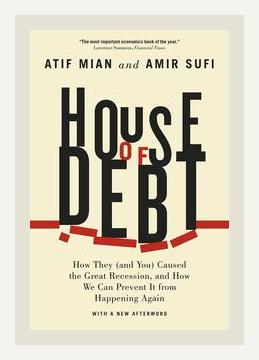Finance, Economics, Trading, InvestingFoundational Economics
Introduction
“House of Debt: How They (and You) Caused the Great Recession, and How We Can Prevent It from Happening Again” by Atif Mian and Amir Sufi is a groundbreaking examination of the 2008 financial crisis, challenging the conventional wisdom that blames banks for the downturn. Instead, the authors argue that excessive household debt was the primary driver of the economic collapse. Mian and Sufi, both esteemed economists, present a compelling case that reshapes our understanding of the Great Recession and offers practical solutions to prevent future financial disasters. This book is a must-read for anyone interested in the mechanics of economic crises and the policies needed to create a more resilient economy.
The Roots of the Crisis
The Build-Up of Household Debt
One of the central arguments of “House of Debt” is that the massive accumulation of household debt, particularly in the form of mortgages, set the stage for the financial crisis. Mian and Sufi meticulously trace how easy access to credit, fueled by rising home prices, encouraged households to take on unsustainable levels of debt. They emphasize that this debt was not evenly distributed, but rather concentrated among the most vulnerable households, which were disproportionately affected when the housing bubble burst.
Example: The authors illustrate this point with the story of a typical American family who, during the housing boom, were able to refinance their mortgage multiple times, pulling out equity to finance consumption. When home prices plummeted, these families were left with homes worth far less than their mortgage balances, leading to a wave of defaults that triggered the financial collapse.
Quote: “The collapse in house prices was like a dagger through the heart of the American middle class. Homeowners who were overleveraged were wiped out financially.” This quote highlights the devastating impact of the housing crash on indebted homeowners, a central theme of the book.
The Failure of Policy Responses
Mian and Sufi are critical of the policy responses to the crisis, arguing that they failed to address the root cause of the problem—household debt. Instead, the focus was on stabilizing the banking system, which, while important, did little to help the millions of families struggling with underwater mortgages. The authors contend that a more effective response would have included widespread debt forgiveness or restructuring, which could have mitigated the economic downturn by boosting consumer spending and stabilizing the housing market.
Example: The book cites the Home Affordable Modification Program (HAMP) as an example of a well-intentioned but ultimately ineffective policy. Despite its aim to help homeowners avoid foreclosure, HAMP’s stringent eligibility criteria and slow implementation meant that it fell far short of its goals, reaching only a fraction of the intended beneficiaries.
Quote: “By focusing on the banks rather than the borrowers, policymakers missed the opportunity to stem the tide of foreclosures and stabilize the economy.” This quote underscores the authors’ critique of the policy choices made during the crisis.
The Consequences of the Debt Overhang
The Impact on Consumption and Employment
Mian and Sufi demonstrate that the sharp decline in consumer spending following the housing crash was a direct consequence of the debt overhang. As households struggled to repay their debts, they cut back on spending, leading to a significant drop in demand for goods and services. This contraction in consumption, in turn, led to widespread job losses, particularly in sectors tied to consumer spending, such as retail and construction.
Example: The book provides data showing that regions with the largest declines in house prices and the highest levels of household debt experienced the most severe drops in employment. This evidence supports the authors’ argument that the recession was not just a financial crisis, but also a crisis of consumer demand.
Quote: “The economy’s engine of growth—household spending—had been knocked out of commission by the weight of debt.” This quote encapsulates the central thesis of the book: that the recession was driven by a collapse in consumer spending due to excessive debt.
Lessons for the Future
Preventing Future Crises
In the final sections of “House of Debt,” Mian and Sufi outline a series of policy recommendations designed to prevent future financial crises. They argue that the key to avoiding another Great Recession is to reduce the vulnerability of households to debt. This includes measures such as stricter regulation of mortgage lending, the introduction of financial products that automatically adjust to economic conditions (such as mortgages with principal reductions during downturns), and policies that promote income growth for the middle and lower classes.
Example: The authors advocate for the adoption of “shared responsibility mortgages,” where lenders and borrowers share the risk of a decline in home prices. This type of mortgage would automatically reduce the principal balance if home prices fall, thereby reducing the likelihood of default and stabilizing the housing market.
Quote: “A more resilient economy is one where the risk of financial crises is shared more broadly across society, rather than concentrated in the hands of vulnerable households.” This quote reflects the authors’ vision for a more stable and equitable economic system.
Conclusion
“House of Debt: How They (and You) Caused the Great Recession, and How We Can Prevent It from Happening Again” is a thought-provoking and deeply researched book that challenges the conventional narrative of the 2008 financial crisis. Atif Mian and Amir Sufi convincingly argue that household debt was the central factor in the recession and that addressing this issue is crucial to preventing future economic disasters. The book’s impact has been significant, influencing both academic debates and policy discussions on how to build a more resilient economy. As we face new economic challenges, the lessons from “House of Debt” remain as relevant as ever, offering a roadmap for creating a financial system that works for everyone, not just the wealthy few.
Finance, Economics, Trading, InvestingFoundational Economics
